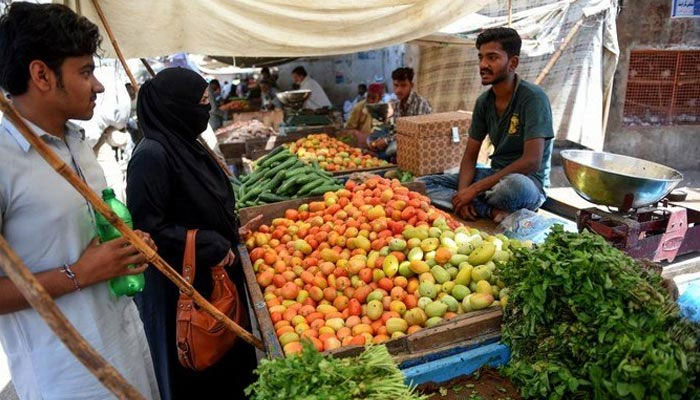Inflation jumps to 24.47pc in December
Pakistan’s CPI inflation in December 2022 rose to 24.47% from 23.84% a month earlier, as the elevated food item prices in the month jacked up the general inflation
ISLAMABAD: Pakistan’s Consumer Price Index (CPI) inflation in December 2022 rose to 24.47 percent from 23.84 percent a month earlier, as the elevated food item prices in the month jacked up the general inflation, the Pakistan Bureau of Statistics (PBS) Monday reported.
The inflation rate has almost doubled now since April 2022’s CPI of 13.4 percent. In the following months, it leaped to higher levels mostly due to food and utility charges. In May 2022, CPI was at 13.8 percent, in June 21.3 percent, July 24.9 percent, in August 27.3 percent (over 47-year record high), in September 23.2 percent, October 26.6 percent, November 23.8 percent and now in December, it jumped to 24.47 percent. In the same month of last year (December 2021), the CPI was 12.28 percent.
Food inflation which occupies 34.58 weightage in the CPI basket, jumped to 35.5 percent in December against 31.16 percent in November 2022, with the biggest increase in the prices of onion by 415 percent, tea by 64 percent, wheat by 57 percent, eggs by 54 percent, gram whole 53 percent, rice 47 percent, gram pulse 45 percent and chicken 44 percent.
Historically, food inflation in Pakistan averaged 8.41 percent from 2011 until 2022, reaching an all-time high of 36.24 percent in October 2022 and a record low of negative 1.06 percent in September 2015.
House rent and utility charges (water, electricity, gas, and fuels) occupy nearly a quarter of CPI. Inflationary pressure in this group, however, declined to 6.95 percent during the month against 9.9 percent in November.
The average inflation in the first half (July-Dec 2022/23) was recorded at 25.02 percent against 0nly 9.8 percent in the same period of FY22. It is to be noted that the Finance Division in its monthly outlook for December 2022 had said that inflationary pressure was easing on the economy, as a month-on-month basis, CPI declined from a high 4.7 percent increase in October to 0.8 percent in November. In December, it increased by half a percent over the previous month.
This politically sensitive price hike has affected millions of poor, especially fixed-income households. Businesses and industries are also facing the brunt, due to higher bank financing due to State Bank’s high discount rate which is currently at 16 percent. It is also a type of ‘invisible tax’ on cash holders, eroding the purchasing power of money.
Rupee devaluation against the US dollar also catalyses the eroding purchasing power of millions of Pakistanis, pushing them under the poverty line as they are unable to make ends meet.
The core inflation (excluding the food and energy components) also increased over the previous month. From 2010 to 2022, core inflation averaged 7.6 percent with the highest reading of 14.9 percent in the month under review [October 2022] and the lowest of 3.4 percent in Sept 2015.
According to the inflation bulletin, the urban core CPI increased by 14.7 percent on a YoY basis in December 2022 against an increase of 14.6 percent in the previous month and 8.3 percent in December 2021. Likewise, the rural core CPI increased 19 percent on a YoY basis in Dec 2022 as compared to 18.5 percent in the last month. On a month-on-month basis, urban core inflation is up by 1.2 percent and rural by 1.5 percent.
Similarly, in December 2022, transportation charges were 41.2 percent costlier against 44.4 percent in November, recreation and culture cost 38.5 percent (25.55pc) Alcoholic beverages and tobacco 36.2 percent (35.9pc in Nov), restaurants and hoteling 27.37 percent (28.37pc).
Similarly, furnishing and household equipment maintenance charges went up 29.23 percent (29.1 pc), health charges by 17.45 percent (17.1 pc), clothing and footwear costs increased by 17.1 percent (18.58pc), and education charges were higher by 10.9 percent against 11 percent in November 2022.
According to the statistical office, urban inflation increased 21.6 percent yearly in December 2022 as compared to an increase of 21.6 percent in the previous month and 12.7 percent in December 2021. The rural CPI also increased 28.8 percent on a year-on-year basis in December 2022 as compared to an increase of 27.2 percent in the previous month and 11.6 percent in December 2021.
The Wholesale Price Index (WPI), another indicator of inflation also increased by 27.1 percent in December 2022 against an increase of 27.7 percent in November 2022 and an increase of 26.2 percent in December 2021. The weekly Sensitive Price Indicator (SPI) also increased by 27.8 percent in the month under review as compared to an increase of 27.1 percent last month and 20.9 percent in Dec 2021.
In a span of one month, the prices of fresh fruits increased by 13.4 percent, onions by 10 percent, Eggs by 9.7 percent, wheat by 9.45 percent, dry fruits by 8.8 percent, rice by 5.85 percent, chicken by 5.4 percent, beans 3.8 percent, wheat flour 3.7 percent, sugar 3.1 percent, milk fresh 1.5 percent over the previous month.
However, the prices of tomatoes decreased by 54 percent, fresh vegetables by 24.9 percent, Potatoes by 21.3 percent, besan by 3.2 percent, pulse masoor by 2.4 percent, pulse gram by 2.1 percent, vegetable ghee by 2 percent, gram whole 1.9 percent, cooking oil 1.4 percent.
On a year-on-year basis, the prices of onions increased 415 percent, tea 64 percent, wheat 57.3 percent, Eggs 54.4 percent, gram whole 53.2 percent, rice 46.6 percent, besan 46.4 percent, pulse gram 45 percent, Chicken 43.8 percent, pulse moong 42.8 percent, mustard oil 41.5 percent, wheat flour 40.6 percent, pulse mash 38.3 percent, cooking oil 32 percent, vegetable ghee 30 percent, milk fresh 26 percent, potatoes 24.7 percent, dry fruits 36.2 percent, fresh fruits 34 percent and pulse masoor by 24.6 percent.
Among non-food items, the charges for motor fuel on a year-on-year basis increased 49.4 percent, washing soap/detergents/matchbox 46.6 percent, stationery 46.6 percent, construction input items 30.6 percent, motor vehicle accessories 29.4 percent, solid fuel 28.6 percent, woolen readymade garments 24.12 percent, household servant 20.5 percent and construction wage rates increased by 13.7 percent over a year ago.
-
 Princess Beatrice, Eugenie Resort To Begging Sarah Ferguson: 'It'll Bring Disaster For The Whole Family'
Princess Beatrice, Eugenie Resort To Begging Sarah Ferguson: 'It'll Bring Disaster For The Whole Family' -
 Jenny Slate Hails Blake Lively Amid Lawsuit Against Justin Baldoni
Jenny Slate Hails Blake Lively Amid Lawsuit Against Justin Baldoni -
 Sophie Wessex Shares 'frustration' From Early Days In Royal Family
Sophie Wessex Shares 'frustration' From Early Days In Royal Family -
 Jason Momoa's Aquaman Unseen Snap Revealed
Jason Momoa's Aquaman Unseen Snap Revealed -
 Prince Harry Taught Only Way King Charles 'will Take Him Seriously'
Prince Harry Taught Only Way King Charles 'will Take Him Seriously' -
 Meghan Markle’s Reaction To UK Talks With Prince Harry Comes To The Forefront: ‘Leaving Me?’
Meghan Markle’s Reaction To UK Talks With Prince Harry Comes To The Forefront: ‘Leaving Me?’ -
 Taylor Swift Slams Justin Baldoni In Explosive Text Messages, Court Filing Reveals
Taylor Swift Slams Justin Baldoni In Explosive Text Messages, Court Filing Reveals -
 Blake Lively’s Drops New Allegations Against Justin Boldoni About Birth Scene
Blake Lively’s Drops New Allegations Against Justin Boldoni About Birth Scene -
 Andrew's Reasons For Giving Sarah Ferguson A Rent-free Home For 30 Years After Divorce Finally Finds An Answer
Andrew's Reasons For Giving Sarah Ferguson A Rent-free Home For 30 Years After Divorce Finally Finds An Answer -
 Charlie Puth Reveals Wake-up Moment That Made Him Quit Alcohol
Charlie Puth Reveals Wake-up Moment That Made Him Quit Alcohol -
 Meghan Trainor Welcomes Baby Girl Mikey Moon Trainor And Turns Emotional
Meghan Trainor Welcomes Baby Girl Mikey Moon Trainor And Turns Emotional -
 Meghan Markle Would Not 'hide Away' From UK For Harry's Sake
Meghan Markle Would Not 'hide Away' From UK For Harry's Sake -
 Why Keith Urban's Daughters Are Avoiding His Rumored Girlfriend? Source
Why Keith Urban's Daughters Are Avoiding His Rumored Girlfriend? Source -
 Sarah Ferguson Led Andrew To Jeffrey Epstein: ‘She Wanted Him To Ask For More Money’
Sarah Ferguson Led Andrew To Jeffrey Epstein: ‘She Wanted Him To Ask For More Money’ -
 Blake Lively Claimed Justin Baldoni 'made A Monster' Of Her, Court Docs Reveal
Blake Lively Claimed Justin Baldoni 'made A Monster' Of Her, Court Docs Reveal -
 Prince William Accused Of 'harsh Decisions' Over Disgraced Royal
Prince William Accused Of 'harsh Decisions' Over Disgraced Royal




